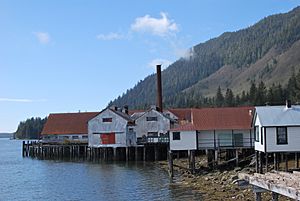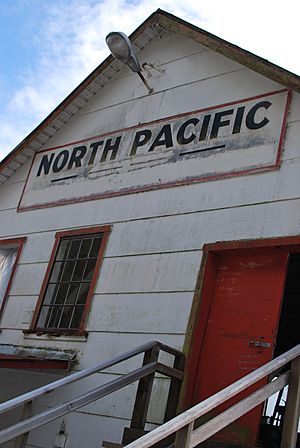North Pacific Cannery National Historic Site facts for kids
The North Pacific Cannery (NPC) is a historic place near Port Edward, British Columbia, Canada. It was one of the oldest fish canneries in that area. A cannery is a factory where fish, like salmon, are cleaned and put into cans to keep them fresh for a long time. NPC was started in 1889 by Angus Rutherford Johnston, John Alexander Carthew, and Alexander Gilmore McCandless. The factory stopped canning salmon in 1968. It then became a plant that made fish meal and oil until it closed in 1981. It had been open for 80 years! Today, it's a museum where you can learn about its past.
Contents
Visiting the North Pacific Cannery Museum
The North Pacific Cannery was built right at the mouth of the Skeena River. This area was known as “Cannery Row” because many canneries were there. John Carthew bought the land for just $32. To save the cannery and turn it into a museum, a group called the North Coast Marine Museum Society needed a lot of money. They managed to get about $4 million by 1989, which was the cannery's 100th birthday!
Today, you can explore 25 buildings at NPC. These include a visitor centre and the canning loft, where fish were processed. You can also see bunkhouses where First Nations and Japanese workers lived. There's also a European house and the Mess House, which is now a small café.
A Look Back: North Pacific Cannery History
The North Pacific Cannery has a long and interesting history. In 1888, the North Pacific Canning Company Ltd. was formed. The next year, in 1889, John Carthew bought the land for the cannery.
Over the years, the cannery changed owners several times. In 1891, Carthew sold it to Henry Ogle Bell-Irving. Then, in 1892, Bell-Irving sold it to the Anglo-British Columbia Packing Company Ltd. That same year, a sad event called “The Big Slide” happened. A landslide destroyed some First Nation homes, and at least nine people died.
The cannery kept growing. By 1900, it had one canning line. Around 1908-1909, worker housing for First Nation and Chinese workers had to be moved because of the Grand Trunk Pacific Railway. This railway, finished in 1914, connected the cannery to the rest of Canada.
In 1918, NPC started making its own cans. It even supplied cans to other canneries nearby! By 1923, it had two canning lines, powered by steam, water, gasoline, and fuel oil. The can-making factory closed in 1936.
Later, in 1955, a "reduction plant" was added. This plant turned fish waste into fish meal and fish oil. In 1959, a road was built along the Skeena River, connecting NPC to Highway 16.
The North Pacific Cannery became part of the Village of Port Edward in 1966. The last year salmon was canned there was 1968. In 1969, The Canadian Fishing Company Ltd. became the new owners. Even after canning stopped, one line was briefly used again in 1972 after a fire at another company.
Saving the Cannery: The North Coast Marine Museum Society
In 1979, five people from Port Edward started The North Coast Marine Museum Society. Their goal was to save the North Pacific Cannery. They had first thought about saving the Inverness Cannery next door in 1973, but a fire destroyed it. So, they focused on NPC instead.
The society began by displaying fishing artifacts in a mall in Prince Rupert. In August 1985, they moved all their items to the cannery. In 1987, BC Packers, the owners at the time, gave the North Pacific Cannery to the Village of Port Edward. They also donated $840,000 and $10,000 for its restoration. Because of these efforts, the North Pacific Cannery was recognized as a national historic site.
Images for kids




